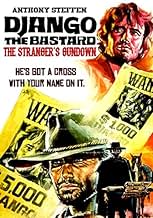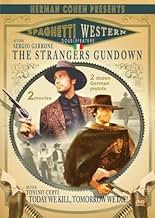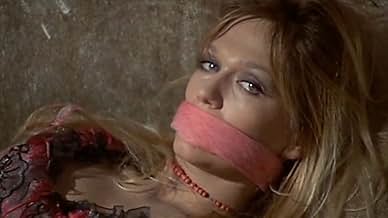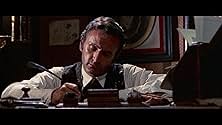AVALIAÇÃO DA IMDb
6,1/10
1,4 mil
SUA AVALIAÇÃO
Adicionar um enredo no seu idiomaA mysterious stranger appears to take terrifying revenge on former Confederate officers who during the Civil War betrayed and were responsible for the massacre of their unit.A mysterious stranger appears to take terrifying revenge on former Confederate officers who during the Civil War betrayed and were responsible for the massacre of their unit.A mysterious stranger appears to take terrifying revenge on former Confederate officers who during the Civil War betrayed and were responsible for the massacre of their unit.
- Direção
- Roteiristas
- Artistas
Luciano Rossi
- Hugh Murdok
- (as Lu Kamante)
Thomas Rudy
- Rowland
- (as Tomas Rudi)
Artemio Antonini
- Hawkins Henchman
- (não creditado)
Ettore Arena
- Murdok Henchman
- (não creditado)
Fortunato Arena
- Murdok Henchman
- (não creditado)
Bruno Ariè
- Hawkens Henchman
- (não creditado)
Ennio Balbo
- Storekeeper
- (não creditado)
Ugo Ballester
- Town Businessman
- (não creditado)
Omero Capanna
- Shotgun
- (não creditado)
- Direção
- Roteiristas
- Elenco e equipe completos
- Produção, bilheteria e muito mais no IMDbPro
Avaliações em destaque
Sort of a conglomeration of ideas stolen from other stolen ideas, with a result that is decidedly unconvincing. Anthony Steffen and his poncho drift about in what has been described as a ghostly manner, seeking revenge on three Confederate Officers who deserted Steffen's unit resulting in a massacre. This set up is fine, but what follows is tedious and repetitious. Character development is totally absent for both the laconic hero and worse for the villains. Steffen may be Italy's answer to Clint Eastwood, but unfortunately there is more to "spaghetti success" than simply wearing a poncho and gunning down endless bad guys. - MERK
Django (Anthony Steffen) scares his enemies by presenting them with crosses bearing their name - and the day of their death. Western movie with horror effects, similar to `E Dio Disse A Caino' by Antonio Margheriti. Christopher Frayling suggested in his book `Spaghetti Westerns' that this `is a revenge film, with the central character avenging HIS OWN death', and that hits it pretty much. Django appears and disappears like a ghost, an idea Clint Eastwood picked up for `High Plains Drifter' two years later.
It is interesting to compare Steffen's expressionless interpretation of the Django character to the one he did in `Pochi dollari per Django', an earlier movie where he portraits Django as a sheriff without all the supernatural attitude, more human and passionate.
It is interesting to compare Steffen's expressionless interpretation of the Django character to the one he did in `Pochi dollari per Django', an earlier movie where he portraits Django as a sheriff without all the supernatural attitude, more human and passionate.
This unusual horror film is one of the best examples of the spaghetti western genre. The plot is the standard "lone stranger seeking revenge," but in this instance, it's not clear if the stranger is a man or just a ghost. This aspect of the story, which is heightened by spooky music and scenes in fog-filled cemeteries, really sets this film apart.
The soundtrack is also excellent, with lots of distorted guitars and sci-fi organ music.
The soundtrack is also excellent, with lots of distorted guitars and sci-fi organ music.
Sergio Garrone's "Django Il Bastardo" aka. "Django The Bastard" of 1969 is referred to by many as a great, creepy and particularly original Spaghetti Western. I am a Spaghetti Western enthusiast, and although "Django The Bastard" is certainly not a bad film, it is in my opinion overrated by many of my fellow fans of the Italian Western. Furthermore it is neither the only, nor the first, nor the best Spaghetti Western with Horror elements. This film also has the reputation of being the inspiration to Clint Eastwood's great "High Plain's Drifter" of 1973, and it might be true that parts of this movie inspired Eastwood, but "Django the Bastard" does in no way reach the quality and style of Eastwood's film.
First of all - "Django The Bastard" (such as most of the other unofficial 'sequels') has nothing at all to do with Sergio Corbucci's 1966 masterpiece "Django" with Franco Nero in the lead. While the original Django is a former Union soldier, the central character of the same name in this movie, which plays in 1882, has formerly served in the confederate army. "Django The Bastard" is a movie that has its highs an lows. There are some excellent, stylish and creepy moments, one of my favorite scenes in the film is right in the beginning, when Django sticks a cross with a name on it in the muddy ground of a Western town. However, the movie sometimes just gets too boring in the middle. Most of the dialogue is not too refreshing either. There is one character i loved, that is the character of Luke Murdoch (played by Luciano Rossi), the hideous and utterly insane younger brother of the local crime boss and rich landowner Rod Murdoch (Paolo Gozlino). Luke, who is desperately in love and obsessed with a woman named Alethea (Rada Rassimov) and often has a fit of extreme rage and insanity, can only be calmed down by Alethea, which is the reason why his brother keeps her locked in his mansion.
Anthony Steffen (Antonio De Teffe) fits pretty well in his leading role of the creepy silent stranger, although his performance is a little too stiff. As I mentioned above, Luciano Rossi also does a great job as the crazy villain. Rada Rassimov (whom you might recognize for her small role in "The Good, The Bad And The Ugly") also plays her role pretty well.
"Django The Bastard" is certainly an entertaining little Spaghetti Western, but nonetheless I think it is overpraised by some of my fellow Spaghetti Western fans. Fans of the genre will certainly have a good time watching "Django The Bastard" but, in my opinion, it is not a must-see. If you want to watch a truly great Spaghetti Western with horror elements and topics like resurrection in it, I recommend Giulio Questi's surreal and excellent "Se Sei Vivo Spara" aka. "Django Kill... If You Live, Shoot!" of 1967, with Tomas Milian in the lead, before watching this. Still, "Django The Bastard" is certainly not a bad film. It does have some very stylish, and some pretty creepy moments, and it is certainly worth the time. Recommended to enthusiastic Spaghetti Western fans.
First of all - "Django The Bastard" (such as most of the other unofficial 'sequels') has nothing at all to do with Sergio Corbucci's 1966 masterpiece "Django" with Franco Nero in the lead. While the original Django is a former Union soldier, the central character of the same name in this movie, which plays in 1882, has formerly served in the confederate army. "Django The Bastard" is a movie that has its highs an lows. There are some excellent, stylish and creepy moments, one of my favorite scenes in the film is right in the beginning, when Django sticks a cross with a name on it in the muddy ground of a Western town. However, the movie sometimes just gets too boring in the middle. Most of the dialogue is not too refreshing either. There is one character i loved, that is the character of Luke Murdoch (played by Luciano Rossi), the hideous and utterly insane younger brother of the local crime boss and rich landowner Rod Murdoch (Paolo Gozlino). Luke, who is desperately in love and obsessed with a woman named Alethea (Rada Rassimov) and often has a fit of extreme rage and insanity, can only be calmed down by Alethea, which is the reason why his brother keeps her locked in his mansion.
Anthony Steffen (Antonio De Teffe) fits pretty well in his leading role of the creepy silent stranger, although his performance is a little too stiff. As I mentioned above, Luciano Rossi also does a great job as the crazy villain. Rada Rassimov (whom you might recognize for her small role in "The Good, The Bad And The Ugly") also plays her role pretty well.
"Django The Bastard" is certainly an entertaining little Spaghetti Western, but nonetheless I think it is overpraised by some of my fellow Spaghetti Western fans. Fans of the genre will certainly have a good time watching "Django The Bastard" but, in my opinion, it is not a must-see. If you want to watch a truly great Spaghetti Western with horror elements and topics like resurrection in it, I recommend Giulio Questi's surreal and excellent "Se Sei Vivo Spara" aka. "Django Kill... If You Live, Shoot!" of 1967, with Tomas Milian in the lead, before watching this. Still, "Django The Bastard" is certainly not a bad film. It does have some very stylish, and some pretty creepy moments, and it is certainly worth the time. Recommended to enthusiastic Spaghetti Western fans.
"Wait a minute stranger, please...tell me who you are anyway"... a baddie asks Django, who replies, "A devil from hell"!! So yes...this movie certainly plays like a typical Italian horrorfilm.You know, one that takes place in an old remote castle where various people are destined to die horroble deaths. Technically this Sergio Garrone film is a much more skillful production than some of his "women in kz-lager" efforts of which he is so "famous"!!! The first 30-45 mins are visually very stimulating and this bears the film through. But after an hour or so, with lots'a style, thrills, atmosphere,moods etc, it just becomes too much(for me at least!!). Django appears everywhere never showing any facial expressions shooting down tons of baddies.Quite frankly, it borders on the tediously boring!!
The ghostly happenings does set the film apart from most other entries in this fine genre and for this I praise and recommend it.
The ghostly happenings does set the film apart from most other entries in this fine genre and for this I praise and recommend it.
Você sabia?
- Erros de gravaçãoDuring the first shootout Django shoots eight times from his six gun without reloading.
- Versões alternativasTHe original Italian version of this film has a precredits explanatory scene: the betrayal of the confederates, and their subsequent massacre. For the English dubbed export version, this flashback was moved later in the film, and this is the version of the film available on DVD in America (from VCI) and on VHS in the UK (from Aktiv). The Italian DVD release contains the original Italian version of the film, with the flashback positioned before the credits as the filmmakers intended.
- ConexõesReferenced in Django: The One and Only (2003)
Principais escolhas
Faça login para avaliar e ver a lista de recomendações personalizadas
- How long is Django the Bastard?Fornecido pela Alexa
Detalhes
- Data de lançamento
- País de origem
- Idioma
- Também conhecido como
- Django the Bastard
- Locações de filme
- Villa Mussolini, Roma, Lazio, Itália(The residence of Major Rod Murdok)
- Empresas de produção
- Consulte mais créditos da empresa na IMDbPro
- Tempo de duração1 hora 38 minutos
- Mixagem de som
- Proporção
- 2.35 : 1
Contribua para esta página
Sugerir uma alteração ou adicionar conteúdo ausente











